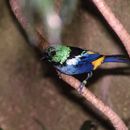Biology
provided by Arkive
Seven-coloured tanagers are usually seen in pairs or groups of up to four individuals, often in mixed-species flocks of varying composition (4). The diet primarily comprises small fruits, berries and seeds, but reportedly also includes the occasional insect (4) (5).
The breeding season of this small bird occurs in the austral spring and summer (October to March) (2). Nests made of twigs are constructed in different arboreal bromeliads up to at least 15 meters off the ground (4) 95). Clutches of three to four eggs are typical, incubated for 15 to 17 days (5). Sexual maturity is apparently attained at one year of age (5).
Conservation
provided by Arkive
The seven-coloured tanager is listed on CITES Appendix II, and has been protected under Brazilian law since 1965 (2) (4). The species has been recorded in Dunas de Natal State Park, Charles Darwin Ecological Refuge, Mata do Pau Ferro Ecological Park, Serra dos Cavalos UFPE, Tapacurá, and Murici Ecological Stations, and Saltinho and Pedra Talhada Biological Reserves. However, adequate protection of both the bird and its forest habitat within these 'protected areas' is often lacking on the ground, such as at the recently decreed Murici Ecological Station, where forest loss continues due to pasture encroachment and charcoal production. However, significant areas are being reforested at Pedra Talhada, where protection is effectively enforced by guards and apparently welcomed by local communities (2). Natural regeneration and forestation schemes being undertaken elsewhere in the country may benefit this species, whose ability to inhabit second-growth forest is encouraging and provides hope for its future survival (2) (4). Some captive birds are being confiscated and released back into reserves, but this will only succeed if these areas are better protected and legal measures are more strictly enforced to prevent trade (2).
Description
provided by Arkive
Aptly named, this spectacularly colourful species is amongst the most beautiful of all birds. The head, chin and mantle are a striking turquoise-green, set off vividly against the black of the throat, bill and surrounding area. The underparts are bright blue on the breast, becoming darker ultramarine on the belly. Wing-coverts are a paler turquoise-blue, and there is dark blue edging to the wing and tail feathers. In stark contrast to most of the plumage, the rump and lower back are a bright, fiery orange, and broad orange edging colours the wing tertials. Females are duller but similarly patterned (2).
Habitat
provided by Arkive
Found in the canopy and edges of lowland and montane forest, usually mature Atlantic and humid forest, but also in severely degraded second growth and, at some sites, regularly in gardens and orchards with bromeliad-laden trees (2) (4). Nests are situated in dense mid-storey vegetation, usually in large bromeliads, indicating that it cannot use second growth without epiphytes (2).
Range
provided by Arkive
The seven-coloured tanager is endemic to north-east Brazil, where it is known from Alagoas, Pernambuci and Paraíba (2) (4).
Status
provided by Arkive
Classified as Vulnerable (VU) on the IUCN Red List (1), and listed on Appendix II of CITES (3).
Threats
provided by Arkive
Encouragingly, the seven-coloured tanager was 'downlisted' from Endangered to Vulnerable on the IUCN Red List in 2004, following important recent discoveries of a number of previously-unknown populations (2) (4). Nevertheless, the bird is still in grave danger of extinction, with the small remaining population in an ongoing decline as a result of habitat loss and trapping to supply the cage-bird trade (2) (4). Just two percent of north-east Brazil's original Atlantic Forest now remains, having been cleared on a massive scale, or replaced by secondary forest without the epiphytes needed for nesting (6), largely as a result of logging and conversion to sugarcane plantations and pastureland (2). Today, just 95 square kilometres of suitable habitat remains, divided over a number of small fragments (6), and most of this is still subject to selective logging and poaching (2) (4). This vibrantly-coloured bird is in high demand for the cage-bird trade, and trapping is heavy due to the high prices commanded by the species' exceptional plumage (2) (6). Professional trappers are able to catch up to 30 seven-coloured tanagers in a single day where the species is at its most common, and law enforcement is noticeably absent, particularly in Alagoas (4). With new roads still being cut through the last remnant forest fragments, access for hunters is getting ever-easier and the chances of long-term survival for this bird look increasingly slim (6).
Seven-colored tanager
provided by wikipedia EN
The seven-colored tanager (Tangara fastuosa) is a vulnerable species of bird in the family Thraupidae. It is endemic to forests in north-eastern Brazil. It resembles the overall greener green-headed tanager; a species confusingly known as the seven-coloured tanager (saíra-sete-cores) in Portuguese.
The seven-colored tanager is a 13.5 cm bird named for the spectacular coloration of its feathers.[3]
- Turquoise-green: Head, chin and mantle
- Black: Lores, area around bill, back, shoulders, and throat
- Bright blue: Breast and edge of tail
- Ultramarine blue: Belly
- Paler turquoise-blue: Wing-coverts
- Dark blue: Edging to wing feathers
- Orange: Edging to tertials, rump and lower back
References

- license
- cc-by-sa-3.0
- copyright
- Wikipedia authors and editors
Seven-colored tanager: Brief Summary
provided by wikipedia EN
The seven-colored tanager (Tangara fastuosa) is a vulnerable species of bird in the family Thraupidae. It is endemic to forests in north-eastern Brazil. It resembles the overall greener green-headed tanager; a species confusingly known as the seven-coloured tanager (saíra-sete-cores) in Portuguese.
The seven-colored tanager is a 13.5 cm bird named for the spectacular coloration of its feathers.
Turquoise-green: Head, chin and mantle Black: Lores, area around bill, back, shoulders, and throat Bright blue: Breast and edge of tail Ultramarine blue: Belly Paler turquoise-blue: Wing-coverts Dark blue: Edging to wing feathers Orange: Edging to tertials, rump and lower back
- license
- cc-by-sa-3.0
- copyright
- Wikipedia authors and editors

